
Original Link: https://www.anandtech.com/show/2906
NVIDIA’s GeForce GT 240: The Card That Doesn't Matter
by Ryan Smith on January 6, 2010 12:00 AM EST- Posted in
- GPUs
Late last year NVIDIA launched the 2nd of their 40nm parts, the GT 240. Based upon the GT215 core, the GT 240 is functionally a derivative of the low-end GT 220. Compared to the GT 220 it packs twice as many shader units, twice as many texture units, and support for GDDR5, making it a good deal faster than the GT 220. As a GT 220 derivative, this also means it comes with DirectX 10.1 support and the VP4 video decode engine.
| Form Factor | 9800 GT |
GT 240 (GDDR5)
|
GT 240 (DDR3) | 9600GT | GT 220 (GDDR3) |
| Stream Processors | 112 | 96 | 96 | 64 | 48 |
| Texture Address / Filtering | 56/56 | 32/32 | 32/32 | 32 / 32 | 16 / 16 |
| ROPs | 16 | 8 | 8 | 16 | 8 |
| Core Clock | 600MHz | 550MHz | 550MHz | 650MHz | 625MHz |
| Shader Clock | 1450MHz | 1340MHz | 1340MHz | 1625MHz | 1360MHz |
| Memory Clock | 1800MHz | 3400MHz | 1580MHz | 1800MHz | 1800MHz |
| Memory Bus Width | 256-bit | 128-bit | 128-bit | 256-bit | 128-bit |
| Frame Buffer | 512MB/1GB | 512MB | 512MB/1GB | 512MB | 512MB |
| Transistor Count | 754M | 727M | 727M | 505M | 486M |
| Manufacturing Process | TSMC 55nm | TSMC 40nm | TSMC 40nm | TSMC 55nm | TSMC 40nm |
| Price Point | $89-$119 | $99 | $89-$99 | $69-$85 | $69-$79 |
NVIDIA’s latest efforts at lowering idle power usage can be seen here, with a 9W idle power usage (only 2W more than the GT 220) while load power is specified as 70W – 70W likely being chosen to avoid the need for a PCIe power connector. The transistor cost of these extra functional units means that the GT 240 comes in at an estimated 727M transistors, occupying a die area we measure at 144mm2.
Unfortunately, not everything got the same boost as compared to the GT 220. Specifically the number of ROPs remains the same at 8, and worse yet the core clock speed is only 550MHz on the GT 240, versus 625MHz (or more) on the GT 220. So not only did the GT 240 not get more rasterizing power to go with its other enhanced abilities, but in fact it’s ever-so-slightly slower than the GT 220 when it comes to rasterizing. For the sake of comparison this is also half as many ROPs as on the 9600GT and 9800GT, both of which are also clocked higher.

As is often the case with lower-end products, the GT 240 is actually composed of two specifications. There is a DDR3 based GT 240, and a GDDR5 based GT 240. The former has 25.44GB/sec of memory bandwidth, while the latter has 54.4GB/sec. This results in 3 cards: An $89 GT 240 with 512MB of DDR3, a $99 GT 240 with 1GB of DDR3, and a $99 GT 240 with 512MB of GDDR5.
Officially, NVIDIA says the following about the GT 240: “The GeForce GT 240 sits between the GeForce GT 220 and GeForce 9800 GT in price and performance.” In essence this is intended to be a significantly faster GT 220, a solid card whose only crime was price.
In theory this is a great position for the card, but reality bites, hard. For starters we have the stratification of the cards based on memory bandwidth. A DDR3 GT 240 is not comparable to a GDDR5 GT 240 in most cases, and you’ll understand why when you see our benchmarks. The memory bandwidth starvation when using DDR3 means that the DDR3 GT 240 is often in its own lesser performance class, a problem when most DDR3 GT 240s are equipped with 1GB of the stuff and sell for as much as their GDDR5 brethren.
The other problem is that while the GT 240 is supposed to be below the 9800GT in price, it’s not. It’s certainly below it in performance, but one can easily find just as many sub-$100 9800GTs as one can GDDR5 GT 240s, including a number from higher-tier manufacturers. For all practical purposes the 512MB 9800GT and the 512MB GDDR5 GT 240 come in at the same price, which as we’ll see makes it very hard to justify the GT 240 when you can get a faster card for the same price.
Finally, there’s the matter to discuss of actually reviewing a card. NVIDIA and their partners are well aware of the problems in positioning the GT 240, so it shouldn’t come as a surprise that no one really wants to talk about these cards. As was the case with the GT 220, NVIDIA did not send out sample cards for the press for review. Even NVIDIA’s vendors are squeamish about the matter, as none of them could get us a card before the launch - one even dropped out after initially offering a card upon realizing that a negative review would be forthcoming.
We can’t really blame NVIDIA or their partners for not wanting to volunteer a card they know would get a poor review, but if you have ever wondered why you don’t see launch-day reviews of these cards like you do more reasonably priced cards, this is why. To that extent we thank eVGA and Asus for sending us GT 240 cards in spite of the poor positioning of the GT 240 line.
With that out of the way, let’s look at today’s cards.

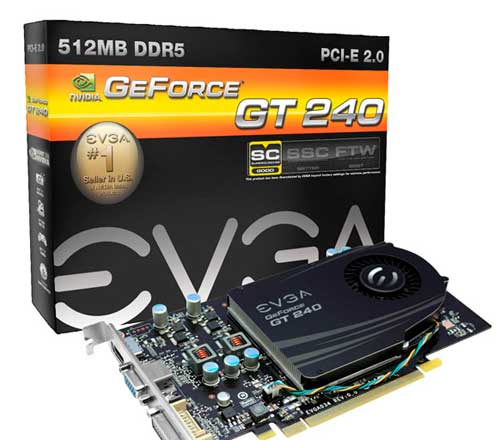
Meet the Asus 1GB DDR3 & 512MB GDDR5
Asus sent us 2 of their GT 240s: the 1GB DDR3 version and the 512MB GDDR5 comparison. This makes for an excellent look at the difference between DDR3 and GDDR5, as the two cards are nearly identical save for the RAM.
Both cards are stock clocked, which means a core clock of 550MHz, and a shader clock of 1340MHz. For the DDR3 card, the RAM is clocked at 1580MHz effective, while the GDDR5 card is clocked at 3400MHZ effective. The DDR3 card is equipped with 1600MHz Hynix RAM chips, while the GDDR5 card is equipped with 4000MHz Samsung RAM chips.

The Asus GeForce GT 240 GDDR5
The amount supporting logic and power circuitry required differs between DDR3 and GDDR5, meaning that the two cards are not perfectly identical. The DDR3 card is slightly shorter than the GDDR5 card, coming in at 6.625”, while the GDDR5 card is 6.875”
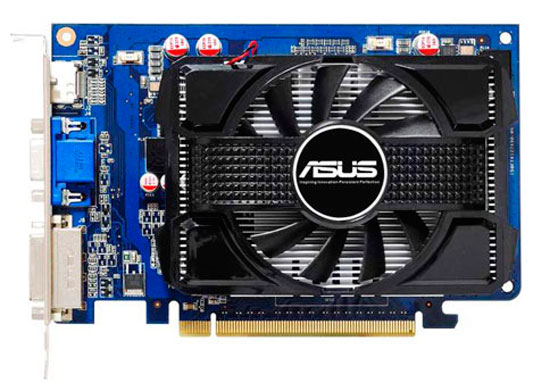
The
Asus GeForce GT 240 DDR3
Both cards are equipped with the same cooler. In this case it’s a double-wide cooler composed of a sizable aluminum heatsink with a not-quite 80mm fan latched on top. The cooler partially covers some of the RAM chips, but only makes contact with the GPU itself.
Finally, both cards are utilizing the same port layout we saw with the GT 220 series - that is an HDMI port, a VGA port, and a DVI port. There are no adapters included in the box, so you’ll need an HDMI to DVI adapter if you want to drive a second digital monitor.
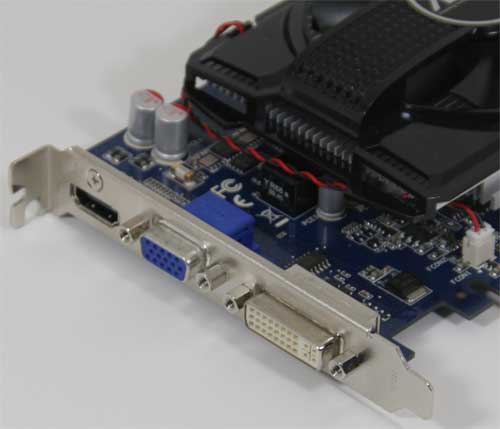
Meet the EVGA 512MB GDDR5 Superclocked
For their GT 240 sample, EVGA sent along their GT 240 Superclocked edition. This card has a stock core and shader clock speed of 550MHz and 1340MHz respectively, while the memory has been pre-overclocked from 3400MHz to 3588MHz, a roughly 5% memory overclock. Notably, EVGA usually overclocks the GPU along with the memory on their Superclocked cards – but given the initial 70W TDP, we’re not surprised to see the GPU stock-clocked in order to keep the card within the 75W PCIe power specification. The RAM chips are the same 4000MHz Samsung chips that we’ve seen on the Asus cards.

Unlike Asus, EVGA has gone for a true single-slot design for the GT 240. A single-wide aluminum heatsink covers the card, with a small fan embedded in a blower configuration. Like the Asus design, this cooler only comes in to contact with the GPU and not the RAM chips. The card measures at 7.5” long, in order to fit the electronics components around the single-slot cooler.
The port configuration is the same as on the Asus cards and the GT 240: 1 HDMI, 1 VGA, and 1 DVI.
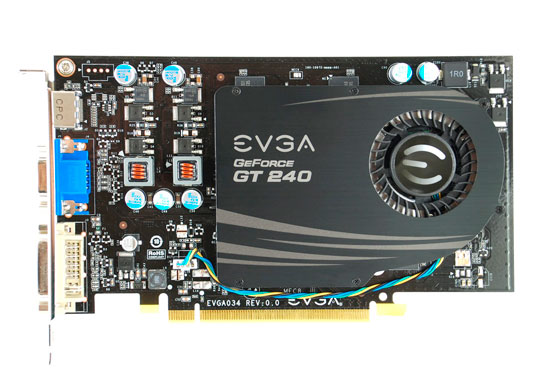
Since this is a factory-overclocked card, the MSRP is higher than the normal GT 240 MSRP. EVGA lists the card at $120 on their site, but we’ve seen it for $99 after rebate, putting it only a few dollars more than most GDDR5 GT 240s.
The Test
For this review, our GT 240 cards were benchmarked using the Forceware 195.62 drivers, as our normal 190.62 drivers predate the GT 240. We have not found any significant performance differences between the two driver sets.
Also, as the performance of the GT 240 was understandably lacking at higher resolutions, we have once again used our low-resolution test suite from the GT 220 article.
| CPU: | Intel Core i7-920 @ 3.33GHz |
| Motherboard: | Intel DX58SO (Intel X58) |
| Chipset Drivers: | Intel 9.1.1.1015 (Intel) |
| Hard Disk: | Intel X25-M SSD (80GB) |
| Memory: | Patriot Viper DDR3-1333 3 x 2GB (7-7-7-20) |
| Video Cards: |
ATI Radeon HD 5870 |
| Video Drivers: |
NVIDIA ForceWare 190.62 |
| OS: | Windows 7 Ultimate 64-bit |
Crysis: Warhead
Kicking things off, we’ll start with Crysis: Warhead. Warhead is still the single most demanding game in our arsenal, with even high-end cards continuing to struggle to put out a playable frame rate with everything turned up.
For testing these lower-end cards, we have deviated some from our normal testing. These tests were done with Mainstream graphics quality at resolutions more appropriate for these cards.
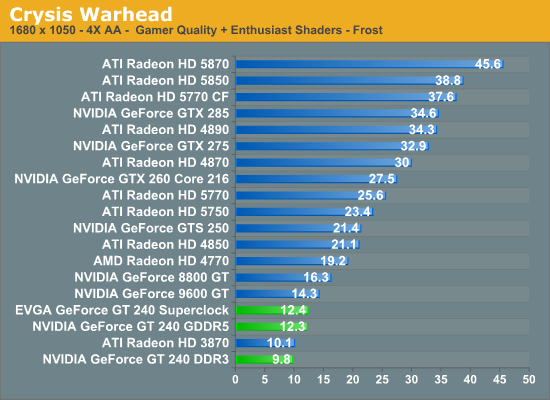

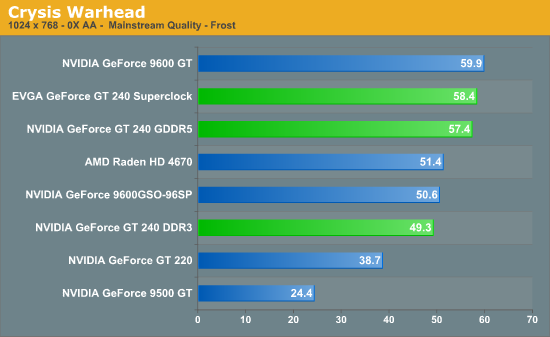
Crysis turned out to be one of our more interesting tests when it comes to differentiating the DDR3 and GDDR5 GT 240s. It’s sensitive to both memory speeds and memory sizes. In fact it’s the first test where we’ve ever explicitly encountered a problem on a 512MB card; at 1680 out Frost benchmark would crash (faulting the driver) about 2/3rds of the way through. Only after disabling Aero on Windows 7 would it run to completion.
Looking at the numbers, you’ll see that this is one of what will be many games where the 1GB DDR3 GT 240 falls behind. At 1680 (an admittedly unplayable resolution) the GDDR5 cards are 25% ahead, while even at a much more playable 1280 they’re ahead by 20%.
Compared to NVIDIA’s other cards, the GDDR5 GT 240s are a good 50% faster than the GT 220. However they fall well behind the 8800 GT, and even the 9600 GT squeezes ahead (a card that has less of everything except ROPs). Based on this and our overclocking data from later, we strongly suspect that Crysis is ROP-limited.
Far Cry 2
Far Cry 2 is another foliage-heavy game. Low-end cards can still do decently here, so long as the texture quality isn’t cranked up to the point where it saturates the 512MB and lesser cards.

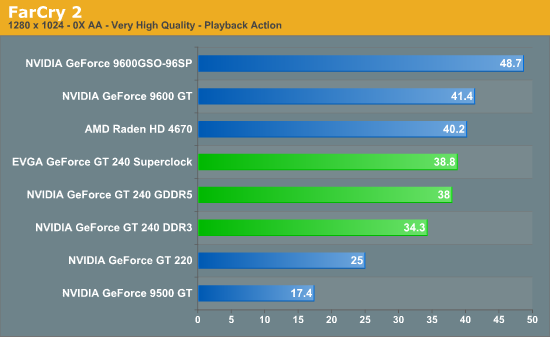

Far Cry 2 is fairly notorious around here for dragging down 512MB cards, and with the GT 240 there is no exception. Any lead offered by GDDR5 melts away thanks to only having 512MB of RAM. The DDR3 GT 240 still doesn’t win here, but it doesn’t lose either, the only time this will happen. This of course goes out the window once we turn our setting slightly down, where the GDDR5 GT 240s are no longer handicapped and resume their lead over the DDR3 GT 240.
At any rate, this really isn’t that great of a game for any of the GT 240s. At lower resolutions, the Radeon 4670 manages to squeeze in above the GT 240s, a battle the GT 240 shouldn’t be losing. The near-parity with the 9600 GT doesn’t look much better, either.
Battleforge
BattleForge is EA’s card-based online-only RTS. As the first DirectX11 title it’s of particular importance for the latest rendition of DirectX, although in this case we aren’t using any features that would be impacted by it. Even without ambient occlusion, BattleForge manages to be a rather punishing game for GPUs.

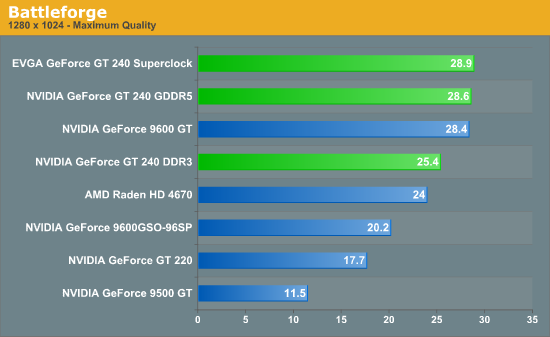

The extra shading power of the GT 240 finally gets to show itself, as it ends up within spitting distance of the 8800 GT and slightly above the 9600 GT. The DDR3 version of the card still trails the GDDR5 version by 10-15% however.
We haven’t talked about the EVGA GT 240 Superclocked yet, so we’ll take a moment here to talk about it. Without a GPU overclock, it only barely manages to separate itself from the pack. A fraction of a frame per second here and there makes it faster than the GT 240 in our charts, but not appreciably so. The GT 240 doesn’t appear to be bandwidth starved when coupled with GDDR5.
HAWX
HAWX is a game that’s not particularly GPU-bound, so even our low-end cards have a fighting chance here.
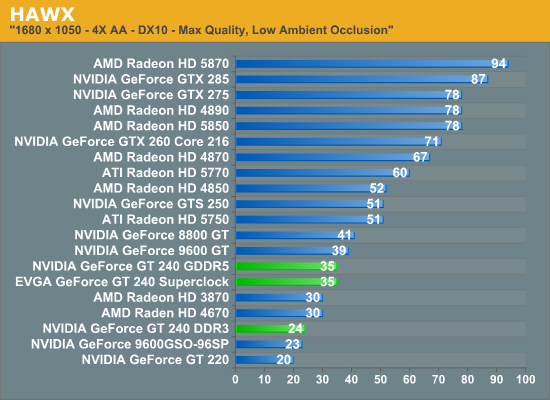
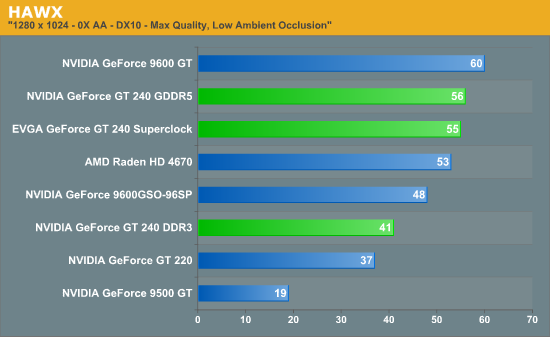
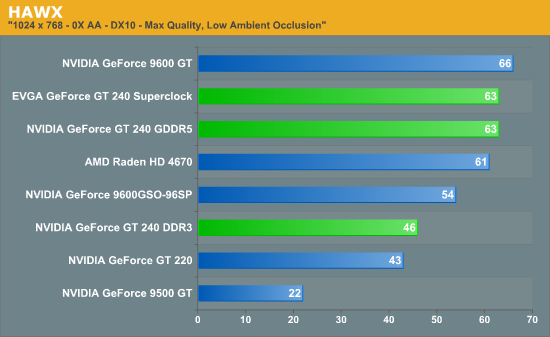
HAWX is particularly rough on the DDR3 GT 240. The difference in performance is anywhere between 40% and 45%, the largest gap we’ll see today between these cards. HAWX is clearly very memory bandwidth sensitive, and it hurts the DDR3 GT 240 here. When you’re only a few FPS off of the GT 220, you know you have problems. Meanwhile the 9600 GT, which has a bit more memory bandwidth than even the GDDR5 GT 240, manages to pull ahead here. EVGA’s memory overclock isn’t enough to settle the differences, it’s not even enough to show a difference on the 1680 chart by virtue of HAWX reporting only whole-number framerates.
Dawn of War II
Dawn of War II is our other RTS benchmark. It’s among the more challenging games in our collection, leading to there being a definite cutoff for playability.
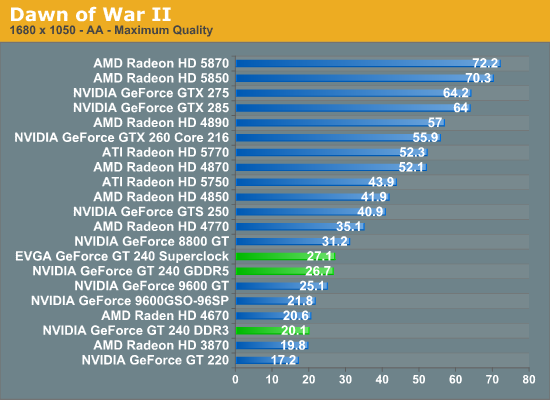
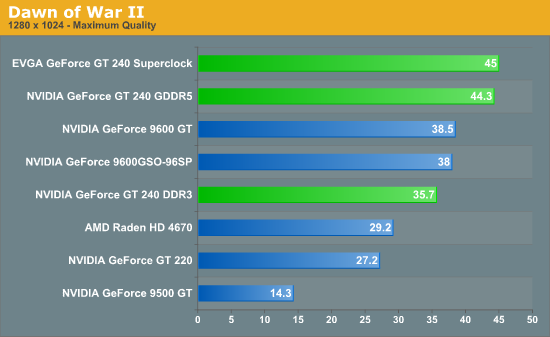
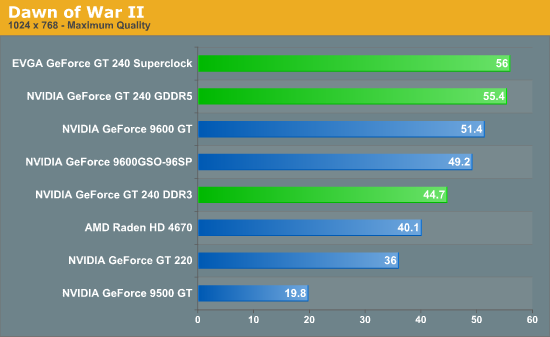
Dawn of War II is another game that apparently favors shader power over all else. The GDDR5 GT 240s beat the 9600 GT in all cases, particularly when we move below 1680. The Raden 4670 also handily loses here, something that’s to NVIDIA’s advantage since it can be much closer in other games.
Meanwhile for the DDR3 GT 240, this is another rough game. At 1680, the GDDR5 cards pull ahead by nearly 33%.
Resident Evil 5
Resident Evil 5 is the latest installment of Capcom’s popular survival horror. As is often the case with console ports, it’s not particularly GPU starved
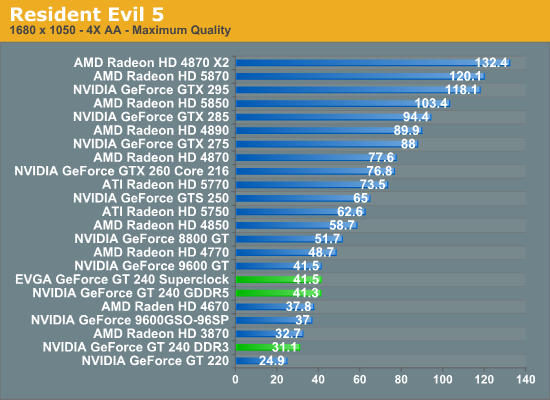
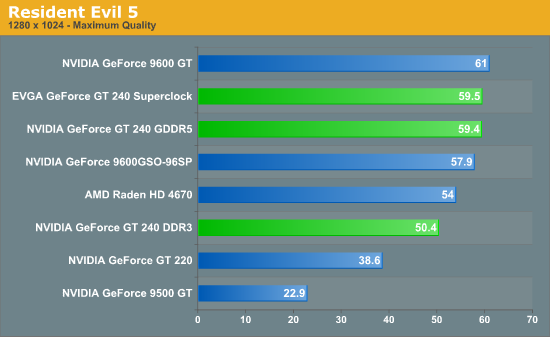

RE5 is not a game with a heavy emphasis on shaders, so the GT 240 is at a disadvantage here. It manages to keep parity with the 9600 GT, but the 8800 GT smokes it. Also smoked is the DDR3 GT 240 at our highest resolutions.
Batman: Arkham Asylum
Batman: Arkham Asylum is another brand-new PC game, and has been burning up the review charts. It’s an Unreal Engine 3 based game, something that’s not immediately obvious from just looking at it, which is rare for UE3 based games.
As Batman: Arkham Asylum implements anti-aliasing differently between AMD and NVIDIA cards, this is the one title that we do not test AA on, as doing so produces results that can’t be compared.
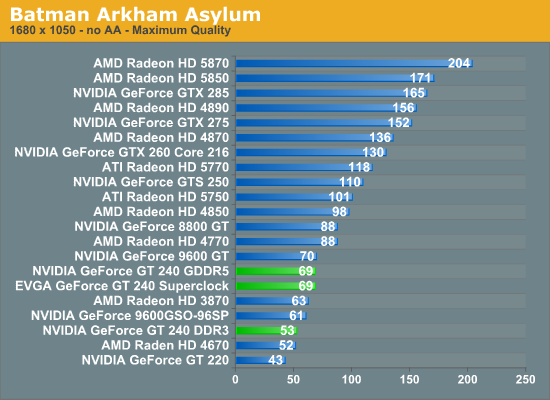
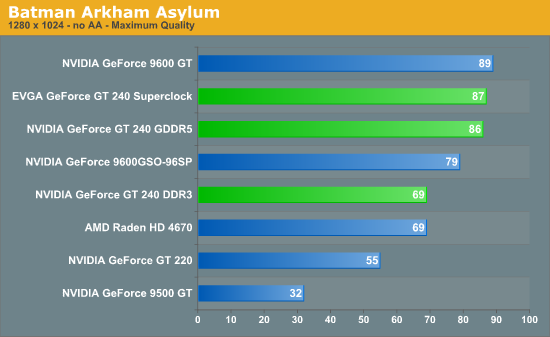
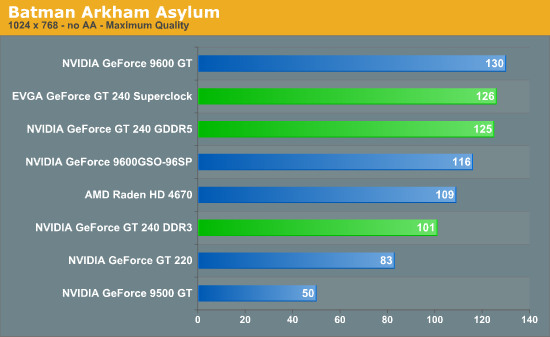
As another console port, the story is very similar to Resident Evil 5. The GT 240 is smoked by the 8800 GT and keeps parity with the 9600 GT. These higher resolutions aren’t doing the DDR3 GT 240 any good either, where it loses by 30% at 1680.
The one good piece of news is that this is a game where even the DDR3 GT 240 can beat the Radeon 4670. Furthermore at 69fps, the GDDR5 GT 240s have no problem achieving a fully fluid framerate, even at 1680.
Left 4 Dead
Valve’s venerable Source engine continues to roll on with Left 4 Dead, their co-op zombie shooter. As the Source engine is CPU limited, this is another title that low-end cards can do well at.
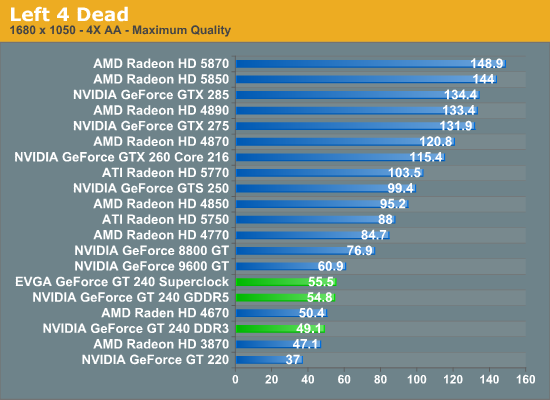
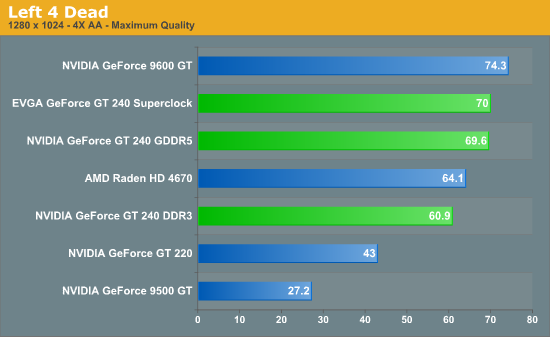
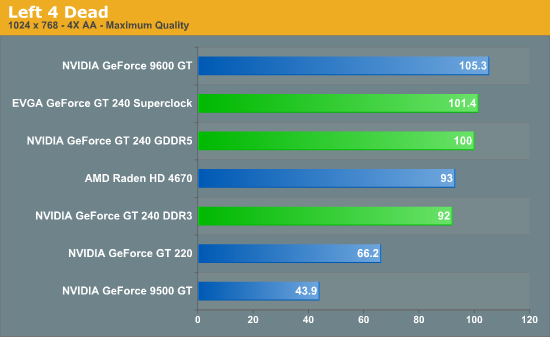
Left 4 Dead is a mixed bag for the GT 240. On the positive side, even with 4x AA it has no issue pulling off fluid framerates at 1680, and the gap between the DDR3 and GDDR5 cards is fairly muted. On the other hand it’s below parity with the 9600 GT at times, never mind the 8800 GT.
Overclocking
As we briefly mentioned in the introduction, the GT 240 has a 70W TDP, one we believe to be chosen specifically to get as much out of the card as possible without breaking the 75W limit of a PCIe slot. Based on the lower core and shader clock speeds of the GT 240 compared to the GT 220 (not to mention the 8800 GT) we believe it to be a reasonable assumption that the GPU is capable of a great deal more, so long as you’re willing to throw the 75W limit out the window.
There’s also the matter of the RAM. The DDR3 card is a lost cause anyhow thanks to its low performance and the fact that it’s only 10MHz below its RAM’s rated limit, but the GDDR5 cards have great potential. The Samsung chips on those cards are rated for 4000MHz effective, some 17% more than the stock speed of 3400MHz effective. If the memory bus can hold up, then that’s a freebie overclock.
So with that in mind, we took to overclocking our two GDDR5 cards: The Asus GT 240 512MB GDDR5, and the EVGA GT 240 512MB GDDR5 Superclocked.
For the Asus card, we managed to bring it to 640MHz core, 4000MHz RAM, and 1475MHz shader clock. This is an improvement of 16%, 17%, and 10% respectively. We believe that this card is actually capable of more, but we have encountered an interesting quirk with it.
When we attempt to define custom clock speeds on it, our watt meter shows the power usage of our test rig dropping by a few watts, which under normal circumstances doesn’t make any sense. We suspect that the voltage on the GPU core is being reduced when the card is overclocked, however there’s currently no way to read the GPU voltage of a GT 240, so we can’t confirm this. However it does fit all of our data, and makes even more sense once we look at the EVGA card.
For the EVGA card, we managed to bring it to 650MHz core, 4000MHz RAM, and 1700MHz shader clock. This is an improvement of 18%, 11%, and 27% respectively.
Compared to our Asus card, we do not get any anomalous power readings when attempting to overclock it, so if our GPU core voltage theory is correct, then this would explain why the two cards overclocked so differently. In any case, the significant shader overclocking should be quite beneficial in what shader-bound situations exist for the GT 240.
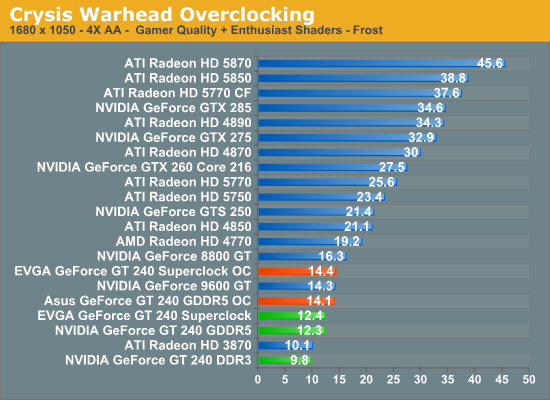
Crysis gives us some very interesting results when overclocked, and this data helps cement the idea that Crysis is ROP-bound on the GT 240. Compared to a stock GT 240, our overclocked Asus and EVGA cards get roughly 15% and 17% more performance. More interestingly, they’re only a few tenths of a frame apart, even though the EVGA card has its shaders clocked significantly higher.
As the performance difference almost perfectly matches the core overclock, this makes Crysis an excellent candidate for proving that the GT 240 can be ROP-bound. It’s a shame that the GT 240’s core doesn’t overclock more than the shaders, as given the ROP weakness we’d rather have more core clockspeed than shader clockspeed in our overclocking efforts.
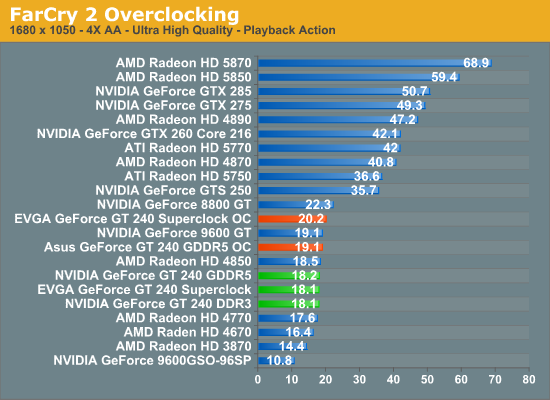
When it comes to Far Cry 2, the significant shader speed differences finally make themselves more apparent. Our cards are still suffering from RAM limitations, but it’s still enough to get another 10% out of the EVGA card.
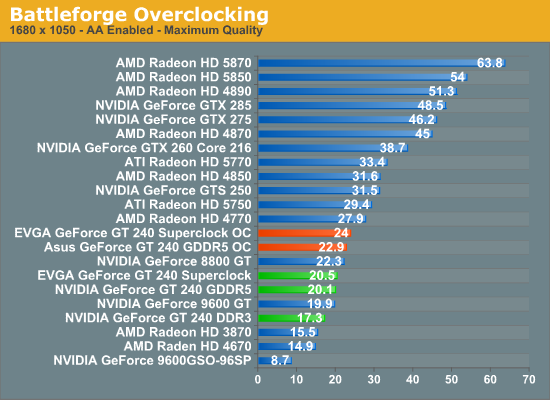
Finally with Battleforge we can see a full stratification of results. The overclocked EVGA card is some 19% faster than a stock GT 240, and 5% faster than the overclocked Asus. Meanwhile the Asus is 14% faster than stock, even with its more limited shader overclock.
Finally, on a quick note we’ll talk about power usage. As we mentioned previously only the EVGA card behaved correctly when overclocking – in overclocking that card we saw a 21W jump from 172W under load to 193W under load. If indeed that card is at or close to 70W under normal circumstances as NVIDIA’s specifications call for, then when overclocked it’s over 90W. It becomes readily apparent here that the clock speeds of the GT 240 were picked by NVIDIA to meet the PCIe power limit rather than the capabilities of the GPU itself.
Power, Temperature, & Noise
With an idle power draw of 9W, and a load power draw of only 70W, the GT 240 should fare fairly well here. As an added bonus, with the significantly different designs of the Asus and EVGA cards, we have a chance to see the difference in performance for their respective coolers.
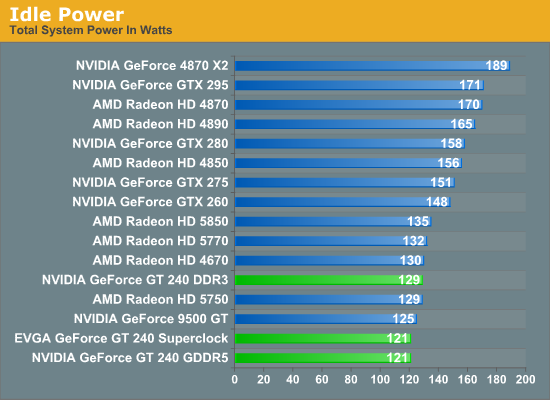
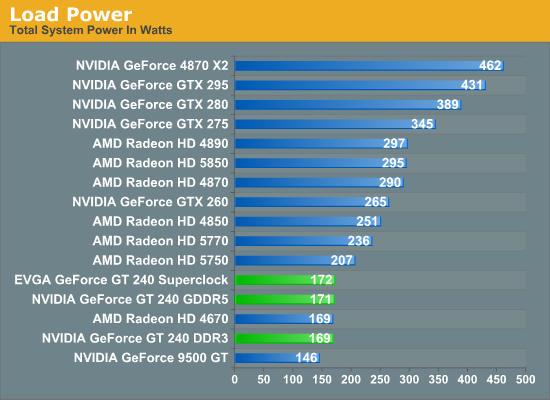
Due to some unrelated issues we don’t have the GT 220 in these charts, leaving the GDDR5 GT 240 as our least power-hungry card when it comes to idling. Unfortunately our DDR3 GT 240 refused to (or is simply not programmed to) idle, meaning that it comes in a good 8W higher than the GDDR5 versions of the cards. The lack of true idling for the DDR3 card will have some ramifications later.
Under load, these cards are still near the top of our charts. The only thing that’s significantly lower is the otherwise anemic 9500 GT while the Radeon 4670 is in a dead-heat. Between the GT 240 cards themselves, even with the different in RAM types, they’re all within 2W of each other. These would probably make fair HTPC cards, but the GT 220 should be a bit less power hungry and cooler.
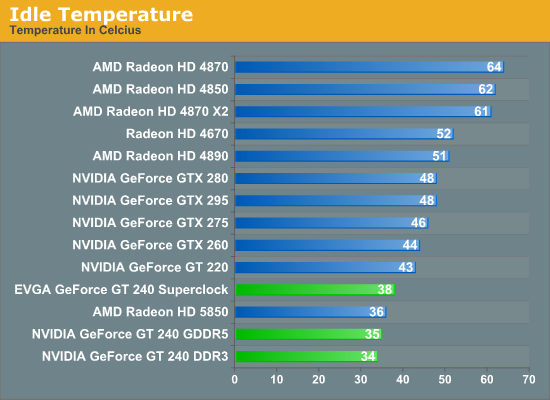
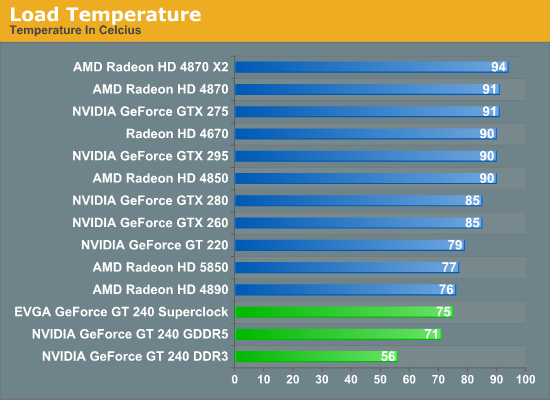
All of these cards push the limits of what’s practical for idle temperatures, although the Radeon 5850 is finally dethroned here by 2 of our GT 240 cards. The double-wide cooler on the Asus cards looks to be good for a couple more degrees than the single-wide cooler on the EVGA card is.
Load temperatures tell us a somewhat different story however. Ignoring the DDR3 card for a second, both the Asus and EVGA cards are quite cool. Our stock Asus card is some 8C cooler than our GT 220, and 19C cooler than the Radeon 4670. The EVGA card meanwhile is 4C cooler than the GT 220, and still 15C cooler than the 4670 in spite of the use of similar single-slot coolers. For what the GT 240 lacks in performance, it can certainly make up for in temperatures.
As for the DDR3 card, in spite of having the same cooler Asus has opted to run the fan at a higher speed. This makes it cooler, but as we’ll see it makes it louder too.
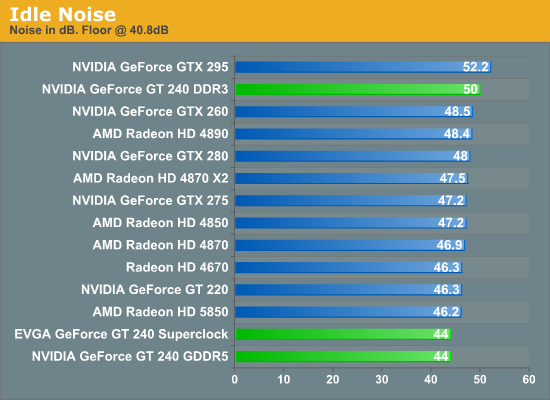
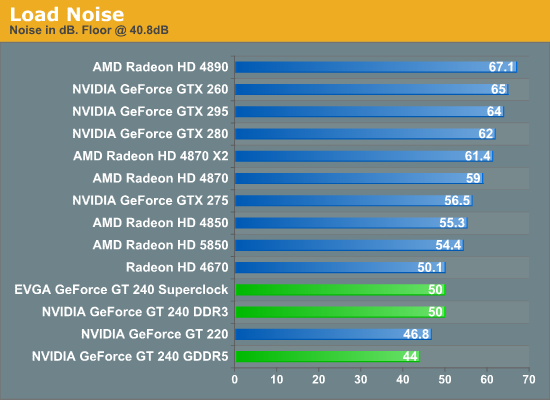
At idle, there’s not much of a story for the GDDR5 cards. They all run up against the ambient noise generated by the rest of the computer. Active and passively cooled cards are nearly indistinguishable at this point. The Asus DDR3 card however is quite distinguishable and is at the bottom of our charts. Its higher fan speeds means that it even idles at a pretty high speed, making it the second-loudest thing after the GTX 295.
It’s under load that the story takes a turn for the most interesting. At 50dB is the Asus DDR3 card and the EVGA card – the former continuing to use its high fan speeds, and the latter having to rev up to make up for its smaller single-slot cooler. Even at 50dB, these cards are quieter than everything besides the otherwise lower-powered GT 220.
Meanwhile down at 44dB is the Asus GDDR5 card, generating the same amount of noise as if it were idling. Based on these results, the card is for all practical purposes indistinguishable from a passively cooled card. Through the combination of a large fan and a large heatsink, the amount of noise the card generates falls below the ambient noise of the rest of the computer. The card is effectively silent.
Now we suspect that if we had a rig specifically for testing silent cards we would find a more notable difference, but in our i7 920 rig there is none to be found. The Asus GT 240 GDDR5 is the quietest actively cooled card we have tested to date, something we were not expecting to find on a GT 240 card. Also bear in mind that this the second-coolest card we have ever tested, falling behind only our overly loud DDR3 card. In the future, someone is probably going to make a very nice fully-passive card out of the GT 240 if all of this can be accomplished with the Asus cooler.
Conclusion
In wrapping things up, perhaps it’s best if we start off with the most positive news. Asus and EVGA have been able to take NVIDIA’s GeForce GT 240 and make from it some of the coolest and quietest cards we have ever tested. The Asus GeForce GT 240 GDDR5 in particular has the best balance of noise and GPU temperatures that we have ever seen, and if you don’t mind a double-wide card it’s for all practical purposes a well-cooled passively-cooled card – it’s that quiet.
Meanwhile the EVGA GeForce GT 240 GDDR5 Superclock not only does a good job of fitting the GT 240 in to a single-slot design, but it showcases the strong overclocking potential of the GT 240 GPU. Its only shame is that for a factory-overclocked card it really isn’t a notable overclock, thanks to the fact that EVGA is trapped by the 75W power ceiling for a PCIe card without secondary power plugs.
And that’s really all of the good news that there is.
I hesitate to call the GT 240 a “bad” GPU – neither NVIDIA or AMD have made a truly bad product in a number of years. Every product has its place if NVIDIA, AMD, and their partners can find it and put it there. However the DDR3-based GT 240s get quite close to this mark with their poor performance compared to their equally-priced GDDR5-based counterparts, and for that reason we must suggest to avoid the DDR3 GT 240 at all costs. If you have to get a GT 240, then get one with GDDR5, as the performance difference is simply too much to ignore.
Ultimately, NVIDIA and their partners repeated the GT 220 launch, having failed to find the right place for the GT 240 in the consumer market. As a result even for well-designed cards like the Asus and EVGA cards, they’re just not desirable cards worth purchasing at these prices.
The root of the problem is that NVIDIA has built other, better cards. Performance-wise the GT 240 is a fair replacement for the 9600 GT, a card that it trades blows with most of the time. It’s not any better in performance than the 9600 GT and the DX10.1 and VP4 video decode functionality are of very limited use, but if the 9600 GT were to disappear from the market and be replaced by the GT 240 at a lower price-point, I don’t think anyone would complain.
But with an MSRP of $99, that’s not what the GT 240 competes with. $99 is solidly in 9800 GT territory, with deals regularly bringing even top-tier manufacturers’ cards down to as low as $79. So even if you throw a rebate on a GT 240 card (we found the Asus for $85 after rebate), you’re still competing with 9800 GT cards. The GT 240 is no match for the 9800 GT when it comes to performance, so to price it at the same point is a mistake.
Worse yet for the GT 240 are the so-called “green” 9800 GTs. These cards are clocked slightly lower than a regular 9800 GT (550/1375/1800 versus 600/1500/1800), but in return their power consumption is low enough that they can forgo the PCIe power connector. There goes the GT 240’s power advantage, and such a 9800 GT is still going to be faster than the GT 240.
In some ways NVIDIA is a victim of their own success here. The G92(b) chip that the heart of the 9800 and GTS 250 series is an extremely popular chip that has sold well for over 2 years now, and there are no signs of that stopping in the near future. Unlike the GT200 chip found in the GTX200 series, the G92b has not yet been discontinued, so it’s going to continue to butt heads with the GT 240.
Like the GT 220, the GT 240 is a card that is going to be a card that only OEMs could love. It’s going to nicely fill out their spec sheets but it’s not going to bring lower prices or better performance to consumers.
For the price of the GT 240 it performs too slowly, and for the performance of the GT 240 it costs too much. We cannot under any circumstances recommend buying a GT 240, there are simply better cards out there for the price.







